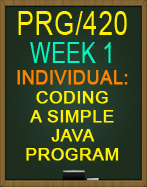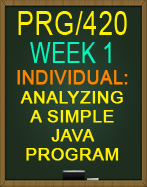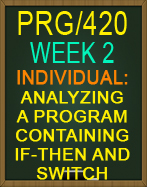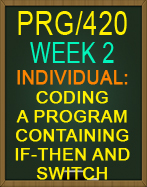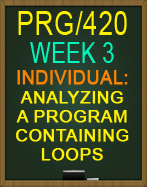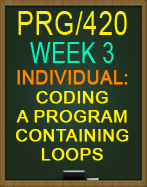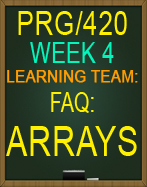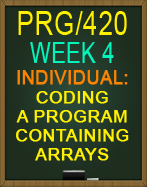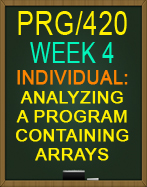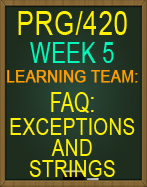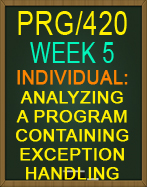PRG/420 Java Programming I |
|
|
Or you may purchase tutorials by the Week below. |
|
|
|
|
PRG/420 Week 1
Everything listed for Week 1 is included in purchase!!
Get ALL Assignments for the week for one LOW Price!
Individual: Analyzing a Simple Java™ Program
Includes Working Java Build and Program File and Explanation of Code
Week One Analyze Assignment Zip File
Analyzing Java™ code--that is, reading and predicting the outcome of
Java™ code, given one or more inputs--is an essential skill. The ability
to analyze code allows you to learn from example code and tutorials. It
also allows you to write and debug your own Java™ code.
For this assignment, you will be analyzing the Java™ code in the linked
zip file.
Carefully read through the code line by line, then answer the following
questions in a Microsoft® Word document:
1. What syntax signals a Java™ comment? (In other words, what
symbol(s) tell the Java™ compiler not to process certain text?)
2. Type the line(s) of code that accept user input.
3. Type the line(s) of code that process user input.
4. Type the line(s) of code that produce output.
5. Type the result this program would produce if a user, when
prompted, responded by typing "everyone" and then hit Enter.
6. Type the result this program would produce if a user, when
prompted, responded by typing in "Mickey Mouse" and hit Enter.
7. Type the result this program would produce if a user, when
prompted, responded by typing "Benjamin Franklin" and hit Enter.
Submit your completed Word document using the Assignment Files tab.
Individual: Coding a Simple “Hello, world!” Java™ Program
Includes Working Java Build and Program File and Explanation of Code
Resource: Week One Coding Assigment Zip File (starter code for this
assignment that includes placeholders)
For this assignment, you will apply what you learned in analyzing a
simple Java™ program by writing your own Java™ program. The
Java™ program you write should do the following:
• Display a prompt on the console asking the user to type in his or her
first name
• Construct the greeting string "Hello, nameEntered!"
• Display the constructed greeting on the console
Complete this assignment by doing the following:
1. Download and unzip the linked zip file.
2. Add comments to the code by typing your name and the date in the
multi-line comment header.
3. Replace the following lines with Java™ code as directed in the file:
• LINE 1
• LINE 2
• LINE 3
• LINE 4
4. Comment each line of code you add to explain what you intend the
code to do.
5. Test and modify your Java™ program until it runs without errors and
produces the results as described above.
Note: Refer to this week's analyzing code assignment if you need help.
Submit your Java source (.java) code file using the Assignment Files
tab.
Discussion Question: Getting Help with Java Programming
Most Java™ programmers, whether new to programming or experienced professionals, take advantage of high-quality
online sites that offer Java™ tutorials, reference materials, and programming communities.
High-quality sites such as Oracle®'s The Java™ Tutorials can save you time and effort by providing information such
as example code, tips for working with a specific Java™ development environment, and the latest Java™ libraries.
For this discussion, research and share at least one high-quality website that offers Java™ sample code, Java™ API
references, or Java™ programmer discussions. Apply the following CRAAP criteria when vetting sites:
Discussion Question: Portable languages and Component Reusability
Java is a portable language, and being an object-oriented programming language, it also encourages component re-usability. How does Java achieve these two important features? How are these features desirable in modern software engineering?
Discussion Question: Saving Account as a Class
You are a bank manager and you are helping a new bank teller understand the kind of accounts the bank offers. If a customer comes in asking to open a new savings account, the teller needs to ask what kind of account— passbook savings or certificate of deposit —the customer would like to open. Remind the customer that all accounts with our bank are insured by the FDIC. You should explain that all accounts earn some interest; a savings account’s interest is compounded monthly.
|
|
|
|
|
PRG/420 Week 2
Everything listed for Week 2 is included in purchase!!
Get ALL Assignments for the week for one LOW Price!
Learning Team: FAQ: Decision Constructs
Answer the following questions as a team:
1. In what circumstances would a programmer use if-then-else instead
of if-then?
2. What is the advantage of using the switch statement over a series of
if-then-else statements?
3. Why does my code not recognize the "if/else" lines and fall through
to the "then" code line?
After your team has finished answering the questions collectively, add
them, along with the question text, to your Java FAQ document. Refer
to the Week 1 Task, "Learning Team: Formatting a Java™ FAQ".
The team member responsible for submitting the team's work will
submit the formatted FAQ document containing this week's questions
and answers using the Assignment Files tab.
Individual: Analyzing a Program Containing if-then and switch
Includes Working Java Build and Program File and Explanation of Code
Resource: Week Two Analyze Assignment Zip File
The ability to read through Java™ code and predict the results, given
specific inputs, is an extremely useful skill.
For this assignment, you will be analyzing the Java™ code in the linked
zip file, and predicting the results given specific input.
Carefully read through the code line by line, then answer the following
questions in a Microsoft® Word document:
1. What is the output of the program as it is written?
2. What would the output of the program be if you assigned iAmHappy
to false,
num to 35, and numDayOfWeek to 5?
3. What would the output of the program be if you assigned the
iAmHappy to 5,
num to 50, and numDayOfWeek to 8?
Submit your completed Word document using the Assignment Files tab.
Individual: Coding a Program Containing if-then and switch
Includes Working Java Build and Program File and Explanation of Code
Resources: Week Two Coding Assigment Zip File (starter code for this
assignment that includes placeholders), and Week Two Recommended Activity Zip File (examples of how to code
a switch statement, an if-then-else statement, and how to construct a
string to display text onscreen).
For this assignment, you will apply what you learned in analyzing
Java™ code so far in this course by writing your own Java™ program.
The Java™ program you write should do the following:
• Accept user input that represents the number of sides in a polygon.
Note: The
code to do this is already written for you.
• If input value is not between 3 and 5, display an informative error
message
• If input value is between 3 and 5, use a switch statement to display a
message
that identifies the correct polygon based on the number of
sides matching the
input number (e.g., triangle, rectangle, or polygon)
Complete this assignment by doing the following:
1. Download tnd unzip ahe linked Week Two Coding Assigment Zip
File.
2. Read the file carefully, especially the explanatory comments of what
the existing code does.
3. Add your name and the date in the multi-line comment header.
4. Refer to the following linked Week Two Recommended Activity Zip
File to see examples of how to code all of the Java™ statements (i.e.,
switch, println(), and if-then-else) you will need to write to complete this
assignment.
5. Replace the following lines with Java code as directed in the file:
• LINE 1
• LINE 2
6. Comment each line of code you add to explain what you intend the
code to do.
7. Test and modify your Java™ program until it runs without errors and
produces the results as described above.
Note: Refer to this week's analyzing code assignment if you need help.
Submit your Java source (.java) code file using the Assignment Files
tab.
Variables in Real-Life Programs
Discuss what other industry examples of if/then/else logic you can think of. How might an organization's environment affect a programmer's choice of variable types?
ArrayList
What is the difference between arrays and ArrayList? What are the advantages and disadvantages of an ArrayList, and when should you use an ArrayList over a simple array?
Discussion Question: StringBuilder
What is the difference between string and StringBuilder? What are the advantages and disadvantages of a StringBuilder, and when should you use a StringBuilder over a simple string?
|
|
|
|
|
PRG/420 Week 3
Everything listed for Week 3 is included in purchase!!
Get ALL Assignments for the week for one LOW Price!
Learning Team: FAQ: Loops
Answer the following questions as a team:
1. What is an endless loop, and how can a programmer avoid coding
one?
2. In what situation should a programmer choose a while loop over a
do-while loop, and why?
3. What is a nested loop?
After your team has finished answering the questions collectively, add
them, along with the question text, to your Java FAQ document. Refer
to the Week 1 Task, "Learning Team: Formatting a Java™ FAQ".
The team member responsible for submitting the team's work will
submit the formatted FAQ document containing this week's questions
and answers using the Assignment Files tab.
Individual: Analyzing a Program Containing Loops
Includes Working Java Build and Program File and Explanation of Code
Resource: Week Three Analyze Assignment Zip File
For this assignment, you will be analyzing the Java™ code in the linked
Week Three Analyze Assignment Zip File, and predicting the results.
You will also examine both the code and the output for inconsistencies
and clarity. This Java™ code includes examples of for, while, and dowhile
loops.
Carefully read through the code line by line, then answer the following
questions in a Microsoft® Word document:
1. What is the output of the program as it is written?
2. What improvement(s) could be made to this code to make the
output clearer or more accurate, or to make the code easier to
maintain?
Note: You do not have to make the improvements in the Java™
program, although you certainly may. For this assignment, simply
describe the things you see that would need to be improved to elevate
the code and output to a more professional level. For the code,
consider variable names and hardcoding. For the output, consider
formatting/punctuation, repetition, accuracy of information, and wording.
Submit your completed Word document using the Assignment Files tab.
Individual: Coding a Program Containing Loops
Includes Working Java Build and Program File and Explanation of Code
Resource: Week Three Coding Assigment Zip File (starter code for this
assignment that includes placeholders)
For this assignment, you will apply what you learned in analyzing for,
while, and do-while loops by writing these statements yourself. The
Java™ program you write should do the following:
• Display a pyramid of asterisks onscreen (i.e., a nested for loop)
• Display the integers 10 to 1 in decreasing order, one number per line
(i.e., a while/do-whlie loop)
• Add 7 until the sum becomes greater than 157, at which point the
program should display both the sum and the number of 7s added
Complete this assignment by doing the following:
1. Download and unzip the linked Week Three Coding Assigment Zip
File.
2. Add comments to the code by typing your name and the date in the
multi-line comment header.
3. Replace the following lines with Java™ code as directed in the file:
• LINE 1
• LINE 2
• LINE 3
4. Comment each line of code you add to explain what you intend the
code to do and why you chose each type of loop.
5. Test and modify your Java™ program until it runs without errors and
produces the results as described above.
Note: Refer to this week's analyzing code assignment if you need help.
Submit your Java source (.java) code file using the Assignment Files
tab.
Discussion Question: Loop Syntax
Research and discuss the following:
• Is the following code syntactically correct? How did you determine your answer?
If the following code is not syntactically correct, what is missing? If it is
syntactically correct, what is the expected result?
for ( ; ; ) {
System.out.println("In the body of the loop");
}
- Many programmers use variables named i, j, or k to increment a loop counter, as shown below. However, variables can be named anything a programmer wants to name them, as long as they follow Java™'s syntactical rules for variable names. What are the benefits and drawbacks of using variable names such as i to increment or decrement loop counters vs. other variable names, such as counter or myCounter or hour?
for (int i = 1; i <= 24; i++) { // using i as counter
if (i < 12) { // morning hours
System.out.println(i + " a.m.");
}
else if (i == 12) { // noon is a special case
System.out.println(i + " p.m.");
}
else // afternoon hours {
System.out.println(i-12 + " p.m.");
}
}
Supporting Activity: Loops
Our focus this week is loops.
Select and complete one of the following activities:
Convert the following program from for loop to while loop.
class Arithmetic Progression
{
public static void main (String [] args)
{
int sum = 0;
while (int I != -1)
{
sum = sum + i;
System.out.println(Integer.toString(sum));
}
}
}
Supporting Activity: Conditions
Consider the following conditions
CONDITION 1: while ( !(cChoice == 'Q' || cChoice == 'q') )
CONDITION 2: while ( cChoice != 'Q' || cChoice != 'q' )
Do Conditions 1 and 2 give the same result? What tool or technique would you use to explain the result?
|
|
|
|
|
PRG/420 Week 4
Everything listed for Week 4 is included in purchase!!
Get ALL Assignments for the week for one LOW Price!
Learning Team: FAQ: Arrays
Answer the following questions as a team:
1. What data types can an array contain?
2. How do you delete (remove) a value from an array?
3. How do you "read" (access and display) the values or elements in
an array?
4. What happens to an array when the program ends?
After your team has finished answering the questions collectively, add
them, along with the question text, to your Java FAQ document. Refer
to the Week 1 Task, "Learning Team: Formatting a Java™ FAQ".
The team member responsible for submitting the team's work will
submit the formatted FAQ document containing this week's questions
and answers using the Assignment Files tab.
Individual: Analyzing a Program Containing Arrays
Includes Working Java Build and Program File and Explanation of Code
Both Programs Work and Provide the Same Results but are codes a little differently.
Resource: Week Four Analyze Assignment Zip File
The ability to read through Java™ code and predict the results, given
specific inputs, is an extremely useful skill.
For this assignment, you will be analyzing the Java™ code in the linked
Week Four Analyze Assignment Text File, and answering questions
about the array that appears in the code.
Carefully read through the code line by line, then answer the following
questions in a Microsoft® Word document:
1. If an array had not been chosen to hold the data manipulated in this
program, how else (i.e., with what other data types) could it have been
represented?
2. Which approach, using an array or using the alternative you
identified in question #1, is shorter/easier?
3. What is the output of this program?
4. What would be the result of using a println() statement to display the
value of arraynum[8]?
5. How many values can arraynum contain, and why?
Submit your completed Word document using the Assignment Files tab.
Individual: Coding a Program Containing an Array
Includes Working Java Build and Program File and Explanation of Code - Option#1
Includes Working Java Build and Program File and Explanation of Code - Option#2
Resource: Week Four Coding Assigment Zip File (starter code for this
assignment that includes placeholders)
For this assignment, you will apply what you learned in analyzing a
simple Java™ program by writing your own Java™ program that
creates and accesses an array of integers. The Java™ program you
write should do the following:
• Create an array to hold 10 integers
• Ask the user for an integer. Note: This code has already been written
for you.
• Populate the array. Note: The first element should be the integer
input by the user. The second through tenth elements should each be
the previous element + 100. For example, if the user inputs 10, the first
array value should be 10, the second 110, the third 210, and so on.
• Display the contents of the array on the screen in ascending index
order.
Complete this assignment by doing the following:
1. Download and unzip the linked Week Four Coding Assigment Zip
File.
2. Read each line of the file carefully, including the detailed instructions
at the top.
3. Add comments to the code by typing your name and the date in the
multi-line comment header.
4. Replace the following lines with Java™ code as directed in the file:
• LINE 1
• LINE 2
• LINE 3
• LINE 4
• LINE 5
5. Comment each line of code you add to explain what you intend the
code to do.
6. Test and modify your Java™ program until it runs without errors and
produces the results as described above.
Note: Refer to this week's analyzing code assignment if you need help.
Submit your Java source (.java) code file using the Assignment Files
tab.
Discussion Question: Arrays vs. Databases
Arrays in Java™ are used to hold data as are databases, also.
Research and discuss the differences between these two approaches. In what situations would it be appropriate to use an array to hold data, and in what situations would it be appropriate to use a database instead? Are there any scenarios in which it might be appropriate to use both a database and an array to process data in the same Java™ app?
Discusson Question: Savings Account
You are a bank manager and you are helping a new bank teller understand the kind of accounts the bank offers. If a
customer comes in asking to open a new savings account, the teller needs to ask what kind of account--passbook
savings or certificate of deposit--the customer would like to open. Remind the customer that all accounts with our bank
are insured by the FDIC. You should explain that all accounts earn some interest; a savings account's interest is
compounded monthly. You should assign a unique account number after accepting the customer's initial deposit. If the
customer chooses to receive statements electronically, the system will send an e-mail with a monthly statement; if the
customer chooses not to, then a paper statement will be sent by mail quarterly.
If savings account is a class, give an example of each of the following as it relates to that savings account. Explain
your reasoning behind your example.
• Superclass
• Subclass
Supporting Activity: “is-a”
Using an example from your work or daily life, describe an "is-a" relationship. Why is an "is-a" relationship important
when designing an inheritance between classes? What are the differences between "is-a" and "has-a" relationship?
|
|
|
|
|
PRG/420 Week 5
Everything listed for Week 5 is included in purchase!!
Get ALL Assignments for the week for one LOW Price!
Learning Team: FAQ: Exceptions and Strings
Includes 2 Options!
Answer the following questions as a team:
1. When would a programmer use String vs. StringBuilder?
2. What are Java™ exceptions, and why should programmers handle
them?
3. What is the difference between a Java™ error and a Java™
exception?
4. What is the difference between a checked exception and an
unchecked exception?
After your team has finished answering the questions collectively, add
them, along with the question text, to your Java FAQ document. Refer
to the Week 1 Task, "Learning Team: Formatting a Java™ FAQ".
The team member responsible for submitting the team's work will
submit the formatted FAQ document containing this week's questions
and answers using the Assignment Files tab.
Individual: Analyzing a Program Containing Exception Handling
Includes Working Java Build and Program File and Explanation of Code
Resource: Week Five Analyze Assignment Zip File
For this assignment, you will be analyzing the code in the linked Week
Five Analyze Assignment Zip File. This program contains exception
handling code. You will be evaluating the code and using what you
learned in this week's readings to predict the results based on the
program as written, as well as based on changing the value of a
specific variable.
Carefully read through the code line by line, then answer the following
questions in a Microsoft® Word document:
1. What are the results of the program as written?
2. What results would the program produce if you changed the value of
a from 0 to 3?
Submit your completed Word document using the Assignment Files tab.
Individual: Coding a Program Containing Exception Handling
Includes Working Java Build and Program File and Explanation of Code
Resource: Week Five Coding Assigment Zip File (starter code for this
assignment that includes placeholders)
For this assignment, you will apply what you learned in analyzing a
simple Java™ program by writing your own Java™ program. The
Java™ program you write should do the following:
• Organize the code capable of throwing an exception of type
ParseException as a try block.
• Include a catch block to handle a ParseException error thown by the
try block.
• Include a hard-coded error that results in a ParseException to prove
that the code can catch and handle this type of exception.
Complete this assignment by doing the following:
1. Download and unzip the linked Week Five Coding Assigment Zip
File.
2. Add comments to the code by typing your name and the date in the
multi-line comment header.
3. Replace the following lines with Java™ code as directed in the file:
• LINE 1
• LINE 2
4. Replace the value assigned with one of the variables so that the
program throws an exception.
5. Comment each line of code you add to explain what you intend the
code to do. Be sure to include a comment for the replacement value
you added in Step 4 that causes the program to throw an exception.
6. Test and modify your Java™ program until it runs without errors and
produces the results described above.
Note: Refer to this week's analyzing code assignment if you need help.
Submit your Java application file using the Assignment Files tab.
Discussion Question: Comparisons of Time and Date
This week's supporting activity asks you to create a simple Java™ app that identifies and displays information about the current date, time, and day of week.
If you were not able to complete the Supporting Activity, "Working with Dates," successfully, post the problems you are having with the code. What compiler error appears? If your code compiles, what incorrect output appears?
If you were able to complete the Supporting Activity, "Working with Dates," successfully, help your classmates who are having difficulties.
Research and discuss how you could add to the supporting activity's code by including this comparison:
If today's date is later than January 1, 1980, display "Today is later than January 1, 1980" on the console.
If today's date is earlier than January 1, 2020, display "Today is earlier than January 1, 2020" on the console.
What Java™ methods would you use to code these new requirements?
If you get one or both of these comparisons to work, post the code for your classmates to see.
Supporting Activity: 3 Biggest Challenges
In your opinion, what are the three biggest challenges in planning and designing a solution for a programming problem? What can you do to overcome these challenges? How would you apply these techniques to the programs in this class?
|



